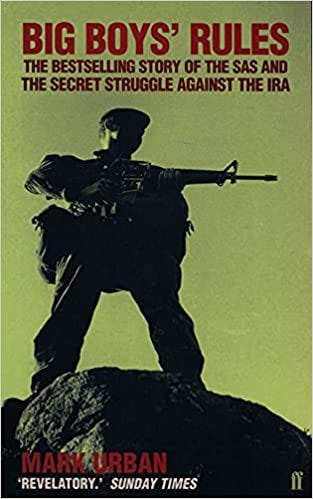Book review - Big Boys' Rules, by Mark Urban
Mark Urban, Big Boys' Rules: The SAS and the Secret Struggle Against the IRA, Faber & Faber, 1992
An influential account of the covert struggle between the security forces and the IRA.
Big Boys' Rules includes a neat diagram at the back of the book which details the evolution, through the 1970s and 80s, of Army and RUC covert units in the areas of surveillance, agent-running and firearms.
The substance of the book details the events underlying that diagram, the successes and failures of changing tactics, the political controversies they provoked, and the ever shifting lines of demarcation between Army and RUC responsibilities.
Urban subjects killings by the security forces to a great deal of scrutiny. Starting with the arrival of the SAS in the 1970s, through the RUC 'shoot to kill' episodes of the early 1980s, which led to the Stalker Affair, to the Loughall ambush which killed eight IRA members in 1987.
Loughgall was the clearest example of the philosophy of the 'clean kill', in which the security forces attempted to use intelligence to ambush IRA members in action. Urban is clear that the 'clean kill' was as much about appearance as reality, and that the courts were often misled about the true circumstances of killings.
Such scrutiny of security force killings stands in stark contrast to Urban's treatment of security force collusion in loyalist killings. Big Boys' Rules was the first book to discuss the Force Research Unit and also includes a great deal of material on 14th Intelligence Company, (whose real name, we now know, was the Special Reconnaissance Unit.)
While Urban acknowledges the moral dilemmas inherent in running agents within paramilitary groups, in this book he concludes that there is no evidence that the security forces deliberately colluded with loyalist death squads.
He provides an extensive critique of allegations to this effect by former British Army officers Colin Wallace and Fred Holroyd. It may be significant that one of Urban's criticisms concerns Holroyd's characterisation of 14 Int/SRU as an SAS unit. Recently released files show that there was indeed extensive SAS involvement in the SRU in the mid-1970s which the state was anxious to conceal.
Since the publication of this book, Urban has himself reported on the Pat Finucane case and the Stevens Inquiry's finding that the security forces were involved in collusion with loyalists. He would, therefore, presumably accept that this book's judgments are outdated on this question. Indeed, I would not be surprised to learn that later editions than my copy (1992) address this.
One cannot help feeling that some of Urban's sources in the security forces may have been involved in something of a 'limited hangout.' Nevertheless, Big Boys' Rules remains an extremely valuable book.
This review was originally published at tomgriffin.org on 23 June 2007.




